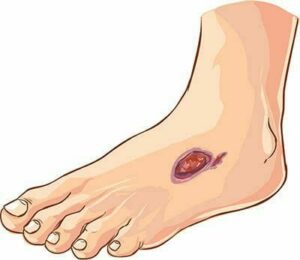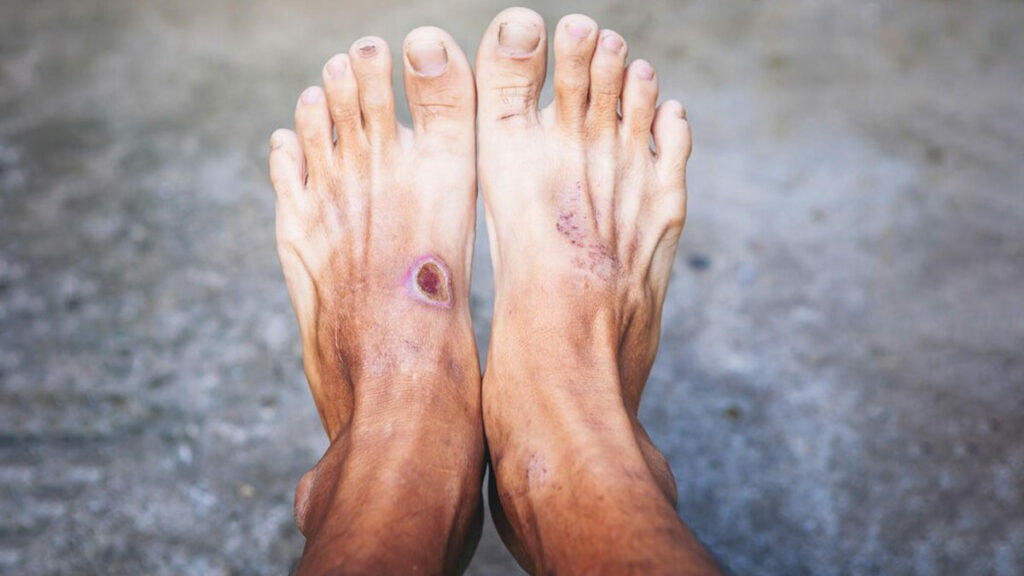Non-Healing Wounds
Your body needs fresh, oxygenated blood to keep your tissue fresh, and maintain a healthy bodily system.
If your body is not receiving the blood it needs, perhaps due to an underlying health condition, serious health complications can ensue, such as non healing wounds or ulcers. If left untreated, non healing wounds and ulcers can pose a serious risk to your health.
Severe cases may lead to amputation of the affected limbs and even death.
Your health is our priority.
Contact us today.
Non-Healing Ulcers Or Wounds

Non-healing wounds or ulcers do not heal normally. If they persist beyond three weeks, they are referred to as chronic wounds.
The extreme ramifications associated with these wounds can be a heavy burden for affected patients. That being said, our board-certified vascular surgeon at Monterey Bay Vascular is dedicated to administering effective treatment and management solutions to all patients so they can live a healthy, pain-free life.
Types Of Non-Healing Ulcers
These account for 70% to 90% of non-healing wounds or non-healing ulcers. Mostly occurring in elderly patients, they are believed to come about as a result of valve failure or diseased valves in the vascular system. These valves are responsible for preventing the backflow of blood as it passes through them. When blood flows backwards, nutrient and oxygen-rich blood is hindered from reaching the tissue that is attempting to heal in the legs and feet.
These ulcers are brought on by restricted blood flow to certain regions of the body due to the persistent and prolonged application of pressure upon them. It is seen most commonly among patients with full or partial paralysis and those who are bedridden for extended periods.
The occurrence of chronic wounds among diabetics makes this demographic 15% more likely to undergo limb amputation as a complication of their diabetic ulcer.
The high rate of limb amputation among diabetics is attributable, in part, to the neuropathic effects associated with diabetes. Neuropathy leads to a lack of pain perception, meaning that you may be entirely unaware of minor wounds on your feet and legs. If these wounds are not treated, the tissue cannot heal and the wound can become infected. The immunosuppressive effects associated with diabetes also make it harder for patients to fight these infections.
Causes of Non-Healing Wounds
The underlying factors contributing to the risk of developing a non-healing wounds or ulcers are widely varied.
What they have in common is their ability to interfere with the way the body normally functions with regard to wounds.
A person’s circulatory system is responsible for delivering blood rich in oxygen and nutrients to all the tissues in the body that need it. Without it, tissues will begin to die. Due to their extremity (distance from the heart) and the effect of gravity, a person’s feet will often be the first problem area for a person with an impaired circulatory system. Peripheral artery disease (PAD) is a particularly culpable condition in this instance as it may lead to numbness, skin discoloration, severe pain, ulcers if left unchecked.
The formation of non-healing wounds or ulcers will indicate that an advanced stage of certain conditions has been reached in a patient. These conditions include high blood pressure, diabetes, kidney failure, high cholesterol, or peripheral artery disease (PAD). These conditions contribute to the formation of ulcers by causing ischemia, or the interruption of oxygenated blood to all parts of the body, or by damaging the nerves in the wounded area.
Various habits and lifestyles will place patients at a heightened risk of developing non-healing ulcers. Smoking, for instance, has the effect of narrowing the vessels carrying blood to the body’s tissues, thus increasing one’s chances of developing ulcers. A sedentary lifestyle involving little to no active movement will also carry the risk of encouraging ulcer development due to the constant pressure applied to certain tissues.
This condition is prevalent in people living with certain circulatory ailments such as atherosclerosis, diabetes, and alcoholism. In a healthy person, the nerves will send signals to the brain whenever pain or discomfort is experienced in the tissues of the body. Neuropathy makes this system non-functional; tissue can be damaged without warning signals being sent to the brain. This will prompt the person to change position or remove the object, causing injury. Over time, the affected area might see the development of an ulcer.
Symptoms of Non-Healing Wounds or Ulcers
If you are at risk for a non-healing wound or ulcer, seeking treatment as early as possible is crucial. If the surrounding tissue is not properly treated, you are at high risk for developing a serious infection.
Look out for the following warning signs of a non-healing wound or ulcer.
- Dark or blue-hued discoloration around the wound’s edges
- Significant pain around the wound that persists without improvement
or progressively gets worse - Foul odor or smell emanating from the wound
- Swelling and redness emanating from the wound and spreading to surrounding skin and tissue
Continuous leaking or draining from the wound.
These symptoms are all conducive with a serious infection.
An infection indicates that your body cannot naturally heal the wound by itself. If you notice any of these signs, seek medical intervention immediately to
avoid any life-threatening complications.

Treatment of Non-Healing Wounds
There are many different causes that may contribute to the development of non-healing ulcers. With that comes an array of treatment methods.
Our doctor will discuss the available options with you in order to formulate an effective treatment plan.
However, the type and severity of the wound will impact of the degree of treatment required to heal the wound.
There are plenty of measures that patients will be able to implement to treat and manage their non-healing wounds or ulcers if they are properly educated. Regular cleaning, sterilization, proper bandage care, manual repositioning of paralyzed limbs, and avoiding habits that contribute to ulcers will be significantly helpful to you.
Compression wrapping helps provide support to the vascular system through a tightly bound wrap around your affected limb. Your veins and arteries have likely been worn down and, as a result, are unable to provide your tissues with proper blood flow. Compression wraps stimulates blood flow and helps your tissues get the nutrients they need to heal your wounds.
Specialized dressings contain medications and other components that aid in wound healing. Topical antibiotics may also be prescribed for non-healing ulcers to reduce the bacterial levels present in the wounds and prevent further infection.
An angiogram with intervention may be recommended. During an angiogram, the physician may perform an atherectomy, place a stent or use angioplasty to open up the arteries and clear away plaque that is preventing adequate blood flow to your legs, feet and wounds. Such procedures may be necessary to treat severe non-healing wounds or ulcers. These procedures are typically performed under local anesthesia, known as conscious or twilight sedation, and can be preformed in private surgical centers or the hospital. Typically, patients go home same day and there is minimal to no recovery time. Restoring blood flow to your limbs helps combat the formation and persistence of non-healing ulcers as well as providesessential levels of oxygen and nutrients to aid in the heeling of active wounds.
Debridement more simply refers to the removal of dead or dying (necrotic) tissue from the site of a non-healing wound. The goal is to minimize the risk or opportunity for infection by eliminating the necessary medium for bacterial growth and proliferation, which such tissue provides. This is an especially relevant measure undertaken in the fight against diabetic non-healing ulcers, as amputation will usually be carried out in cases where infection has progressed past a certain limit.
This is the idea behind the rather outlandish yet scientifically sound application of maggot therapy in the management and treatment of chronic wounds. Here, live, disinfected maggots will be introduced to the wound by a medical professional. Maggots will happily devour necrotic tissue while not touching healthy tissue. This directly leads to a reduction in the bacterial presence in the wound, thus encouraging rapid healing as well as pain and odor mitigation.
Why Monterey Bay Vascular?
At Monterey Bay Vascular, we offer coordinated care to prevent, diagnose, and treat vascular disease.
We understand, everyone deserves to live a long, happy life. Vascular disease may lead to limb loss and other life-threatening conditions such as pulmonary embolism. Our licensed vascular surgeon uses state-of-the-art tools and technology to tackle all problems related to your vascular system. Thanks to our vast wealth of experience, we also work with our patients to develop a unique solution that fits your needs. Contact us today to learn more about the vascular treatments we offer and schedule an appointment today!